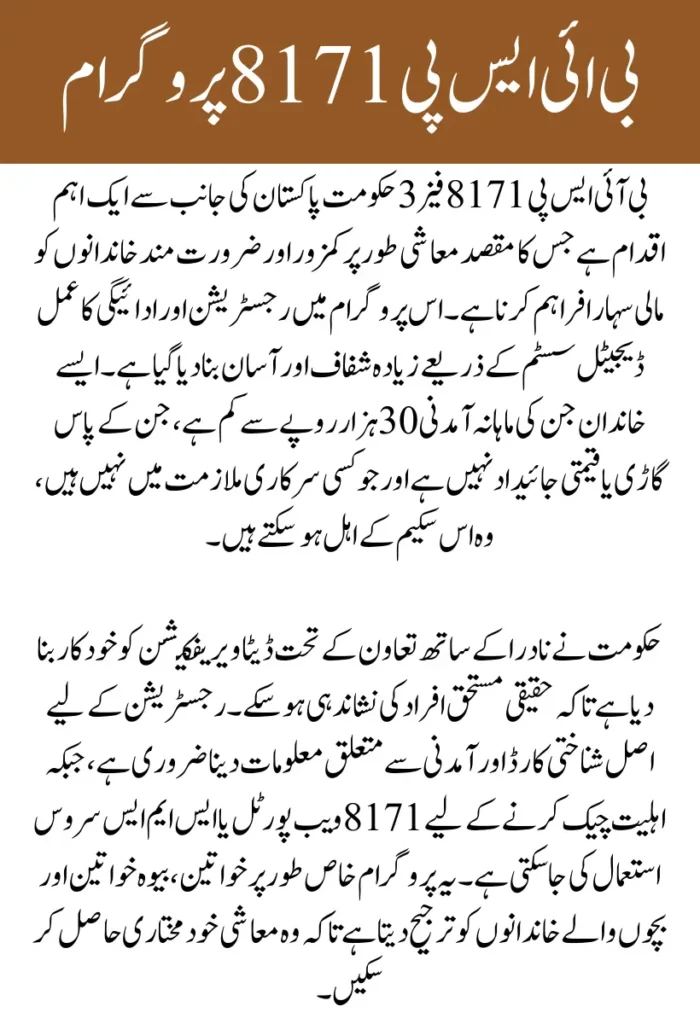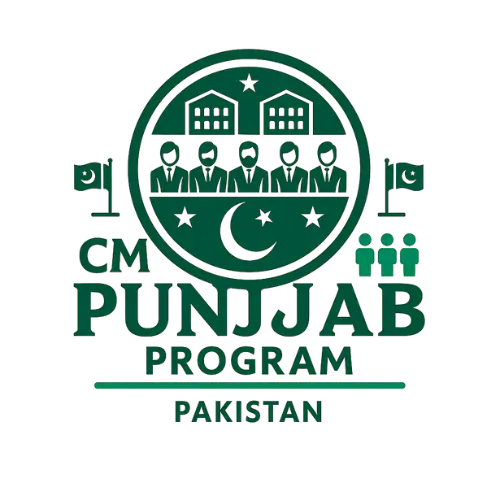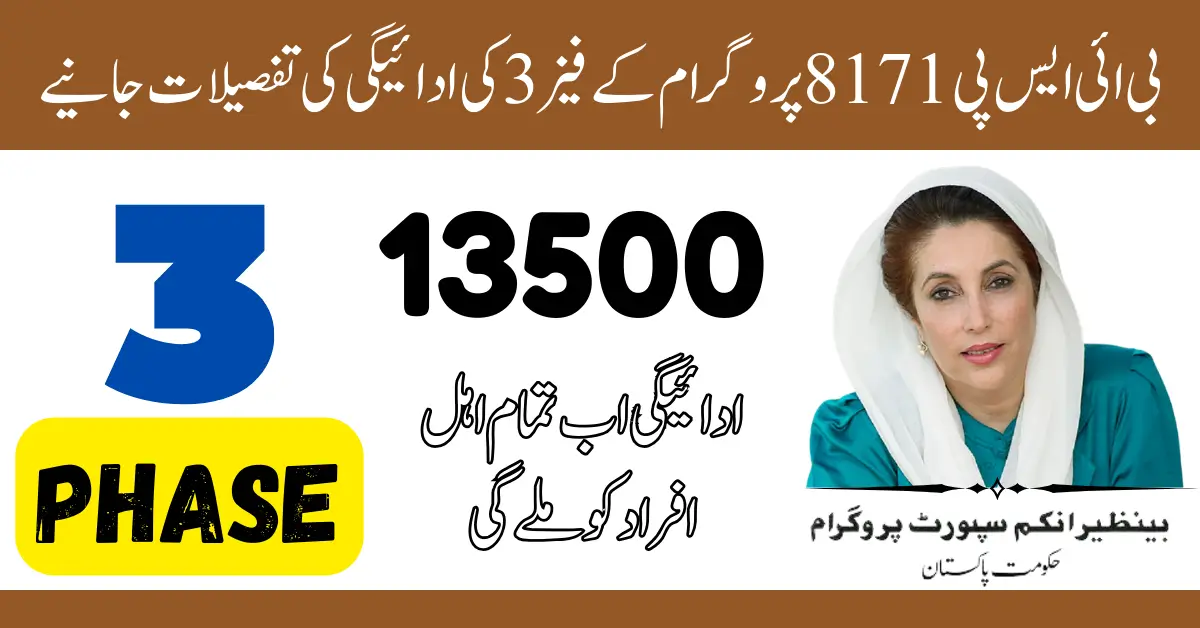The BISP 8171 Phase 3 program continues to provide financial relief to millions of deserving families across Pakistan. This phase is part of the government’s effort to expand support to previously unregistered individuals through improved targeting and digital verification systems. With rising inflation and economic uncertainty, the third phase of BISP offers renewed hope for low-income households.

In this phase, the Benazir Income Support Programme aims to streamline the registration and payment process, ensuring transparency and faster disbursement. Whether you’re looking to apply for the first time or need updates on your payment, understanding the essentials of BISP 8171 Phase 3 is crucial.
For More Information: Ehsaas Kafaalat 13500 Phase 2 Verification
Latest Developments in BISP 8171 Phase 3
The government has introduced new verification steps and regional outreach campaigns under BISP 8171 Phase 3. The focus is on ensuring that only genuinely deserving families are selected. Data sharing between NADRA and BISP allows the system to automatically identify eligible households, reducing the chances of fraud.
بی آئی ایس پی 8171 فیز 3 حکومت پاکستان کی ایک اہم کاوش ہے جس کا مقصد غریب اور مستحق خاندانوں کو مالی معاونت فراہم کرنا ہے۔ اس مرحلے میں رجسٹریشن کا عمل آسان بنایا گیا ہے تاکہ ہر ضرورت مند فرد اپنی معلومات دے کر امداد حاصل کر سکے۔ نادرا کے ساتھ ڈیٹا شیئرنگ کے ذریعے اس بار شفافیت کو مزید بہتر کیا گیا ہے۔ ان خاندانوں کو ترجیح دی جا رہی ہے جن کی آمدنی کم ہے اور جن کے پاس کوئی مستقل ذریعہ معاش نہیں ہے۔
Program Overview
| Category | Details |
|---|---|
| Program Name | BISP 8171 Phase 3 |
| Target Beneficiaries | Low-income families, especially women-led households |
| Eligibility Criteria | – Monthly income below Rs. 30,000- No government job- No vehicle or property ownership |
| Payment Amount | Rs. 13,500 every three months |
| Payment Methods | Visit the BISP center with CNIC, B-Form, income proof, and biometric verification |
| How to Check Eligibility | 8171 web portal (via CNIC) or SMS |
| Registration Process | Visit BISP center with CNIC, B-Form, income proof, and biometric verification |
| Disqualification Reasons | Wrong data, government employment, or owning property |
| Appeal Process | Submit a review request with updated documents at a BISP center |
| Special Focus | HBL/Bank Alfalah transfers, BISP cash centers, and mobile banking |
Eligibility Criteria for BISP 8171 Phase 3
Applicants must meet specific socio-economic standards to qualify for the third phase. These standards are based on the updated National Socio-Economic Registry (NSER) survey.
Eligibility includes:
- Household income less than Rs. 30,000 per month
- No record of government employment
- No ownership of cars or large properties
How to Check Eligibility for BISP 8171 Phase 3
Checking your eligibility has become easier than ever with the dedicated 8171 portal. Whether you’re applying for the first time or rechecking your status, the process is fully digitized.
To check eligibility:
- Go to the 8171 BISP web portal
- Enter your CNIC in the provided field
- Review your eligibility status instantly
For More Information: AKF Punjab Registration is Still Open Apply in May 2025
Payment Details for BISP 8171 Phase 3
Under BISP 8171 Phase 3, each qualified household is entitled to receive Rs. 9,000 every three months. The disbursement is being handled through multiple secure channels to improve accessibility in both rural and urban areas.
Payment methods include:
- Direct transfer via partner banks like HBL and Bank Alfalah
- Cash disbursement at official BISP centers
- Mobile banking for hard-to-reach communities
8171 پورٹل کے ذریعے گھر بیٹھے اپنی اہلیت چیک کرنا ممکن ہو چکا ہے۔ یہ سہولت خاص طور پر ان افراد کے لیے ہے جو دیہی علاقوں میں رہتے ہیں اور بینک یا حکومتی دفاتر تک رسائی نہیں رکھتے۔ اگر کسی کو اہلیت کے پیغام میں مسترد کر دیا جائے تو وہ قریبی بی آئی ایس پی مرکز جا کر اپیل دائر کر سکتا ہے۔ فیز 3 کے ذریعے مستحق خواتین اور بچوں کے لیے مخصوص فنڈز بھی رکھے گئے ہیں تاکہ وہ مالی بحران سے باہر آ سکیں۔
Steps to Register for BISP 8171 Phase 3
If you are not yet registered, visit the nearest BISP registration center to complete the process. You’ll need to undergo a biometric verification and provide household details.
Required documents:
- Original CNIC
- Child registration certificate (B-Form)
- Any proof of income or unemployment status
Reasons for Disqualification in BISP 8171 Phase 3
Many applicants are unaware of the factors that may disqualify them from receiving benefits. It’s important to avoid common mistakes during the registration procedure.
Frequent disqualification causes:
- Submitting outdated or incorrect information
- Existing government employment in the household
- Property ownership exceeding the allowed threshold
For More Information: How to Get BISP 13500 May 2025 Payment Through Bank ATM
How to Appeal a Rejected BISP Application
If you’re deemed ineligible, don’t worry. You can appeal the application and request a review. BISP centers have staff available to help you correct or update your records.
To file an appeal:
- Visit your local BISP support office
- Ask for a data correction or appeal form
- Submit supporting documents for reevaluation
BISP 8171 Phase 3 کے تحت ادائیگیاں باقاعدگی سے ہر تین ماہ بعد کی جا رہی ہیں۔ ہر اہل خاندان کو 13500 روپے دیے جا رہے ہیں تاکہ روزمرہ ضروریات پوری کی جا سکیں۔ اس فیز میں خاص توجہ خواتین کی خود مختاری پر دی جا رہی ہے۔ اگر آپ یا آپ کے اہل خانہ مستحق ہیں تو رجسٹریشن مکمل کر کے اس سکیم سے فائدہ اٹھایا جا سکتا ہے۔ بی آئی ایس پی کا مقصد نہ صرف مالی امداد دینا ہے بلکہ مستحق افراد کو باوقار زندگی گزارنے کے مواقع فراہم کرنا بھی ہے۔
Special Focus on Women and Vulnerable Families
BISP 8171 Phase 3 places strong emphasis on women-led households and those caring for children. Widows, divorced women, and unemployed mothers are being prioritized to receive funds without delay. This ensures better protection for vulnerable groups who often lack access to financial systems.
Conclusion
As BISP 8171 Phase 3 rolls out across Pakistan, eligible families should take immediate steps to check their status and complete the registration process. With updated systems, increased transparency, and regular payments, this initiative remains a crucial lifeline for those struggling to meet basic needs. Staying informed, submitting correct information, and knowing your rights under this program can make a lasting impact on your financial well-being.

